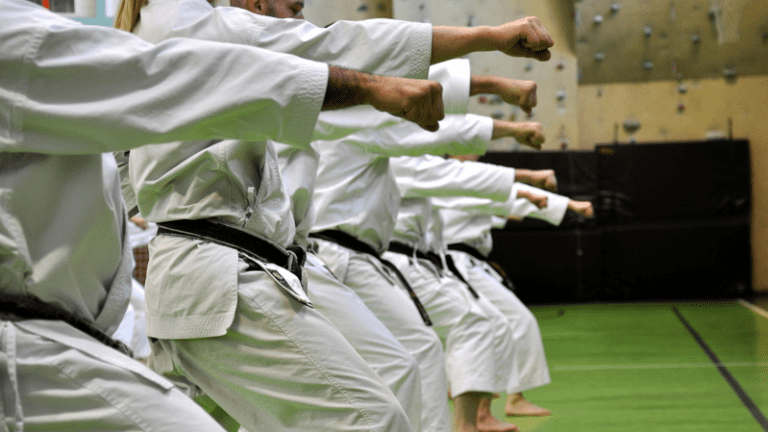When many people think of martial arts, the image of young Bruce Lee flying through the air to kick bad guys pops into their minds. Is it possible to for a person in their 50s, 60s and beyond to participate in martial arts? The answer is resoundingly “yes.”
Many of the martial arts techniques seen in movies are flamboyant and dramatic by design. It is to hold the audience’s interest. In real life, the majority of martial arts styles are practiced with feet firmly on the ground as opposed to being in mid-air. This means that martial arts can be enjoyed by people of all ages and levels of physicality.
There are a vast array of martial arts styles. These include, but are not limited to, Kung Fu, Tai Chi, Karate, Judo, BJJ, Krav Maga, Muay Thai, Tae Kwon Do, and Kali. Even Western Boxing can be viewed as a martial art. The wide menu of styles available means that you can find an art that matches your interest and physicality. The benefits of practicing martial arts extends beyond simply the physical to building self-confidence and keeping the mind sharp. Basic training in martial arts, of course, may also give you a leg up in defending yourself if the need arises.
In his book “Martial Arts After 40”, Martial arts expert Sang H. Kim, PhD, said, “Martial arts can be practiced as long as, if not longer, than just about any other physical pursuit. In fact, martial artists often get better, not worse, with age.”
I have observed first-hand the benefits of martial arts to seniors. Two of my favorite martial arts instructors are walking testimonies to the life-long benefits from martial arts training. Dan Inosanto is a legendary martial artist who at the age of 81 still practices and teaches Jeet Kune Do and Filipino Martial Arts. The speed and fluidity of his movements often match that of students more than half his age. Francis Fong is another well-regarded martial artist. He has been practicing and teaching Wing Chun Kung Fu for over 50 years!
Unfortunately, we lose muscle mass and add fat as we age. The practice of martial arts can offset some of this natural decline in our bodies.
The physical benefits to practicing a martial art include increased flexibility, strength, coordination and endurance.
Typical martial arts training classes include general conditioning exercises, practice of martial arts techniques alone or with a partner, and optional sparring. Many people study martial arts, not so much for self-defense, but for the fun and physical fitness benefits. Therefore, you can practice martial arts without ever engaging in sparring or actual fighting.
Martial arts expert Loren W. Christensen, in his book “Solo Training 3: 50 and Over,” said, “Martial artists who continue to train after 50 and eat a healthy diet are often in better shape than students many years younger. In fact, it’s quite possible for a martial artist in his 70s to have a healthier cardiovascular system and respiratory system, as well as greater strength, than a 50-year old coach potato.”
In addition to the physical benefits, practicing martial arts can help the mind function better as well. There is a strong link between the mind and physical activity. According to Mandy Oaklander in her article, “The New Science of Exercise,” in Time magazine, said “Research links exercise to less depression, better memory and quicker learning.”
When you make the commitment to learn a martial art, the question becomes what style should I sign up for. This is a personal decision based on your purpose for studying a martial art, for example for fitness and/or self-defense, your personal interests and sensibilities, as well as your level of physicality.
For example, some martial arts styles are relatively more rigorous than others. I include Muay Thai and Boxing in that category. Some styles require a great deal of flexibility, such as Tae Kwon Do, which focus on high kicks. There are some martial arts styles that are known for realistic street self-defense, such as Krav Maga or Jeet Kune Do. Tai Chi is often touted for its focus on balance and flexibility, as well as relaxation and stress relief benefits. If weapons are your cup of tea, you can explore some of the Filipino Martial Arts styles, such as Kali, that employ the use of wooden sticks.
Before embarking on a new journey into martial arts, it is advisable to check with your doctor first to make sure you are physically able to train safely. It is also a good idea to visit a few martial arts schools and talk to the instructors. Make sure the school emphasizes the safety of its students. If you see people walking out the door with black eyes and busted lips, you may want to look elsewhere! Many schools offer trial lessons so you can try them out before making a commitment. Once you settle on a martial arts program, stick to it and enjoy the benefits to your physical and mental fitness!
———————————————————-
CoachUp is the safest and easiest way to find a coach for personalized training. With our 100% money-back guarantee and vetted coaches, anyone can achieve their full athletic potential. Find your perfect coach today and become the athlete you want to be!
How useful was this post?
Click on a star to rate it!
Average rating 2 / 5. Vote count: 195
No votes so far! Be the first to rate this post.




